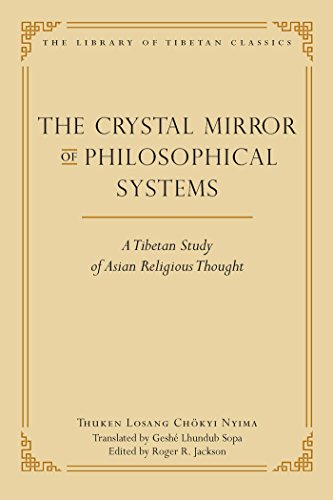|
|
| Line 14: |
Line 14: |
| }} | | }} |
| |FullTextRead=No | | |FullTextRead=No |
| | |BookToc=*{{i|General Editor's Preface|xi}} |
| | *{{i|Translators Preface|xv}} |
| | *{{i|Editors Introduction|1}} |
| | *{{i|Map of Tibet|24}} |
| | *{{i|Technical Note|27}}<br><br> |
| | |
| | *The Crystal Mirror An Excellent Explanation Showing the Sources and Assertions of All Philosophical Systems<br><br> |
| | *{{i|1. Preface|33}} |
| | *{{i|2. Indian Schools|37}} |
| | *{{i|3. Introduction to Tibetan Buddhism|71}} |
| | *{{i|4. The Nyingma Tradition|77}} |
| | *{{i|5. The Kadam Tradition|97}} |
| | *{{i|6. The Kagyü Tradition|117}} |
| | *{{i|7. The Shijé Tradition|157}} |
| | *{{i|8. The Sakya Tradition|169}} |
| | *{{i|9. The Jonang and Minor Traditions|197}} |
| | *{{i|10. The Geluk Tradition 1: Tsongkhapa|215}} |
| | *{{i|11. The Geluk Tradition 2: Tsongkhapa's Successors|267}} |
| | *{{i|12. The Geluk Tradition 3: The Distinctiveness of Geluk|299}} |
| | *{{i|13. The Bön Tradition|321}} |
| | *{{i|14. Chinese Traditions 1: Non-Buddhist|331}} |
| | *{{i|15. Chinese Traditions 2: Buddhist|351}} |
| | *{{i|16. Central Asian Traditions|371}} |
| | *{{i|17. Conclusion|387}}<br><br> |
| | *{{i|Appendix: Detailed Outline of Thuken's Text|397}} |
| | *{{i|Notes|411}} |
| | *{{i|Glossary|497}} |
| | *{{i|Glossary of Enumerations|515}} |
| | *{{i|Bibliography|535}} |
| | *{{i|Index|577}} |
| | *{{i|About the Contributors|66}} |
| |AddRelatedTab=No | | |AddRelatedTab=No |
| }} | | }} |



